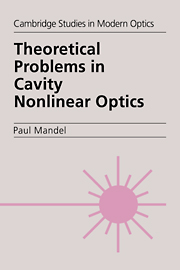Book contents
- Frontmatter
- Contents
- Introduction
- 1 Reduction of the Maxwell–Schrödinger equations
- 2 Parameter swept across a steady bifurcation I
- 3 Parameter swept across a steady bifurcation II
- 4 Optical bistability: Constant input
- 5 Optical bistability: Variable input
- 6 Multimode optical bistability
- 7 Free-running multimode lasers
- 8 Antiphase dynamics
- 9 Laser stability
- 10 Second harmonic generation
- 11 Saturable absorbers
- 12 Transverse effects in optical bistability
- Index
12 - Transverse effects in optical bistability
Published online by Cambridge University Press: 16 October 2009
- Frontmatter
- Contents
- Introduction
- 1 Reduction of the Maxwell–Schrödinger equations
- 2 Parameter swept across a steady bifurcation I
- 3 Parameter swept across a steady bifurcation II
- 4 Optical bistability: Constant input
- 5 Optical bistability: Variable input
- 6 Multimode optical bistability
- 7 Free-running multimode lasers
- 8 Antiphase dynamics
- 9 Laser stability
- 10 Second harmonic generation
- 11 Saturable absorbers
- 12 Transverse effects in optical bistability
- Index
Summary
In this chapter, we remove one assumption that has been implicit since the beginning of this book, namely the unidimensional aspect of the cavity. We now take into account the transverse variation of the field in the resonant cavity. In dealing with transverse effects, there are two possible approaches, very much like in the multimode optical bistability (OB) studied in Chapter 6. One possibility is to project the Maxwell–Bloch equations on a suitable basis. In the introduction of Chapter 6, the difficulty of selecting this suitable basis was explained for 1-D cavities. This difficulty is amplified by the transverse dimensions, especially because of the lateral boundaries. The other approach is to derive global equations (that are still partial differential equations) for slowly varying amplitudes. They are generally variants of well-known nonlinear partial differential equations of mathematical physics, and therefore a large number of results are directly available. However, when transferring results from another domain to optics, some care must be exercised because the relevant domains of parameters are not always compatible. The classic example is the canonical set of parameters for the Lorenz equations that includes b = γ║/γ⊥ = 8/3 whereas for atomic transitions the upper bound of b is 2. The reader will find a wealth of results, mostly for the modal expansions, in the special issues and reviews [1]–[4]. A review more specifically oriented toward the global amplitude equations is found in [5] and a mathematical study of these equations is presented in [6].
- Type
- Chapter
- Information
- Theoretical Problems in Cavity Nonlinear Optics , pp. 160 - 181Publisher: Cambridge University PressPrint publication year: 1997



